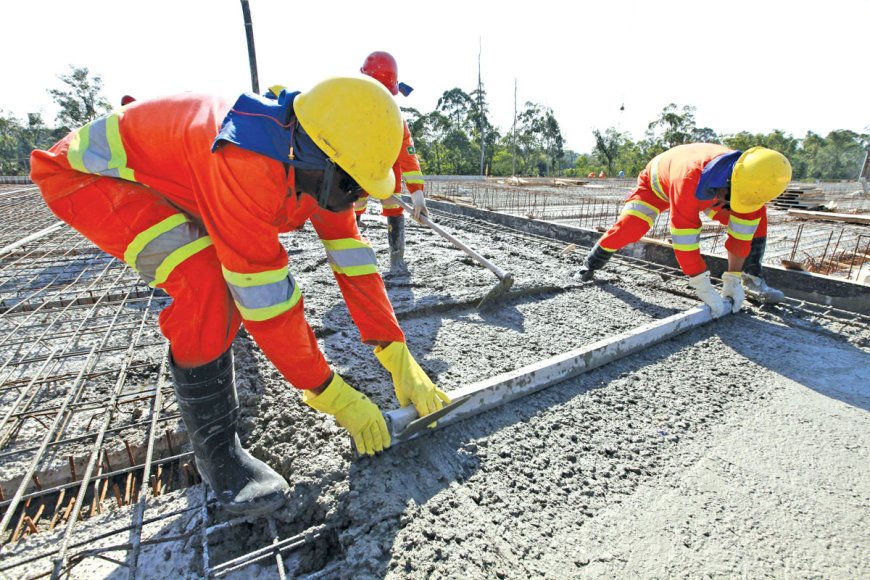Cooling India's urban landscape: High albedo concrete for climate-resilient cities

India's rapid urbanization presents significant challenges, including the exacerbation of urban heat islands (UHIs) due to the proliferation of heat-absorbing materials in construction. High albedo concrete offers a promising solution by reflecting more sunlight and reducing surface temperatures, thereby mitigating UHIs and improving urban livability.
This research paper examines the challenges and opportunities associated with implementing high albedo concrete in India, focusing on its cost-effectiveness, technical feasibility, and potential for addressing climate change. Drawing on global research and local context, the paper proposes strategies for promoting the widespread adoption of high albedo concrete in Indian cities to create cooler, more resilient urban environments.
Introduction
India's urban areas are experiencing rapid growth, accompanied by rising temperatures and increased energy demand for cooling. Urban heat islands (UHIs), exacerbated by the use of heat-absorbing materials like traditional concrete, pose significant challenges to public health, energy consumption, and environmental sustainability.
High albedo concrete, engineered to reflect more sunlight and absorb less heat, offers a promising solution to mitigate UHIs and enhance urban resilience. This research paper explores the potential of high albedo concrete in the Indian context, considering its applications, benefits, challenges, and opportunities for sustainable urban infrastructure development.
Literature review
Previous studies have demonstrated the effectiveness of high albedo concrete in reducing surface temperatures and mitigating UHIs in various urban environments worldwide. Research from countries like the United States, Germany, and Japan has highlighted the technical feasibility and energy-saving potential of this innovative material. However, challenges such as cost concerns, material availability, and durability issues need to be addressed to facilitate its widespread adoption.
In the Indian context, there is a growing recognition of the importance of sustainable construction practices and climate resilience, providing an opportunity to leverage high albedo concrete as part of holistic urban development strategies.
Methodology
This research paper employs a qualitative approach, drawing on a comprehensive review of existing literature, case studies, and expert insights to analyze the challenges and opportunities associated with implementing high albedo concrete in India.
Data from global studies on high albedo concrete's performance, cost-effectiveness, and environmental impact are synthesized to assess its suitability for Indian urban contexts.
The paper also examines government policies, industry trends, and stakeholder perspectives to identify potential barriers and enablers for adoption.
Results and discussion
The analysis reveals that while high albedo concrete offers significant benefits in terms of reducing UHIs, improving energy efficiency, and enhancing urban comfort, several challenges need to be addressed to realize its full potential in India.
These include cost considerations, material sourcing, technical expertise, and durability concerns. However, opportunities such as government initiatives, research collaborations, and public awareness campaigns present avenues for overcoming these challenges and promoting the widespread adoption of high albedo concrete in Indian cities.
Strategies for incentivizing sustainable construction practices, fostering innovation, and building capacity within the construction industry are discussed as key interventions to accelerate the adoption of high albedo concrete.
Challenges and Opportunities of Introducing High Albedo Concrete in India
Cost considerations: One of the primary challenges in introducing high albedo concrete commercially in India is the perceived higher cost compared to traditional concrete. The specialized materials and additional processing steps required to enhance its reflective properties often result in increased production costs.
Material sourcing: India may face challenges in sourcing high-quality, light-colored aggregates and supplementary cementitious materials necessary for manufacturing high albedo concrete. Limited availability and higher costs of these materials could hinder its widespread adoption.
Technical expertise: Ensuring the proper formulation and manufacturing of high albedo concrete requires technical expertise. The construction industry in India may face a shortage of skilled personnel familiar with the specialized requirements of this material, which could affect its quality and performance.
Durability concerns: India's diverse climate, including monsoon rains and high temperatures, poses durability challenges for construction materials. Ensuring that high albedo concrete can withstand these conditions over time is crucial for its acceptance and effectiveness.
Opportunities
Urban heat island mitigation: High albedo concrete presents an opportunity to mitigate the urban heat island effect prevalent in Indian cities, particularly during the summer months. By reflecting more sunlight and reducing surface temperatures, it can enhance outdoor comfort and mitigate heat-related health risks.
Energy savings: India's growing urban population has led to increased energy demand for cooling in buildings. High albedo concrete can contribute to energy savings by reducing the need for air conditioning, thus lowering electricity consumption and greenhouse gas emissions.
Government initiatives: The Indian government has shown interest in promoting sustainable construction practices and climate resilience. Initiatives such as the Smart Cities Mission and Green Building Councils provide platforms for promoting innovative materials like high albedo concrete.
Research and development: Indian institutions and research organizations have the opportunity to contribute to the development of high albedo concrete tailored to the country's specific climate and construction requirements. Collaborations between academia, industry, and government can drive innovation and technology transfer in this field.
Cost considerations
To introduce high albedo concrete commercially in India, several strategies can be considered to address cost concerns:
Economies of scale: With increased demand and production volume, economies of scale can lead to lower unit costs for high albedo concrete. Government incentives or subsidies could be provided to encourage large-scale production and adoption.
Local material sourcing: Promoting the use of locally available materials, such as indigenous aggregates and supplementary cementitious materials, can reduce transportation costs and reliance on imported materials, thereby lowering production costs.
Process optimization: Research and development efforts can focus on optimizing production processes to improve efficiency and reduce costs. Innovations in material formulation, mixing techniques, and surface treatments can enhance the performance of high albedo concrete while minimizing production expenses.
Life cycle cost analysis: Conducting life cycle cost analysis can demonstrate the long-term benefits of high albedo concrete in terms of energy savings, reduced maintenance costs, and environmental impact. By considering the total cost of ownership, stakeholders can make informed decisions regarding its commercial viability.
Way forward
The successful commercial introduction of high albedo concrete in India requires a multi-faceted approach involving stakeholders from government, industry, academia, and civil society. Key steps include:
Policy support: Government policies and regulations can incentivize the adoption of high albedo concrete through tax incentives, subsidies, and building codes that prioritize energy-efficient materials. Public procurement policies can also promote the use of high albedo concrete in government-funded projects.
Capacity building: Investing in training and education programs can build technical expertise within the construction industry to ensure the proper manufacturing, installation, and maintenance of high albedo concrete. Collaboration with academic institutions and vocational training centers can help develop a skilled workforce proficient in sustainable construction practices.
Public awareness: Raising awareness among developers, architects, engineers, and end-users about the benefits of high albedo concrete is crucial for its acceptance and demand. Public awareness campaigns, demonstration projects, and case studies showcasing successful implementations can highlight its effectiveness in mitigating urban heat islands and reducing energy consumption.
Research and innovation: Continued research and innovation are essential to further enhance the performance, durability, and cost-effectiveness of high albedo concrete. Collaborative research projects involving industry, academia, and government can drive technological advancements and address specific challenges relevant to the Indian context.
By addressing cost concerns, leveraging opportunities, and adopting a collaborative approach, India can unlock the potential of high albedo concrete to create cooler, more sustainable urban environments for its growing population.
Conclusion
High albedo concrete represents a paradigm shift in sustainable infrastructure, offering tangible solutions to mitigate the impacts of urbanization and climate change. Through concerted research and development efforts across the globe, its potential applications and benefits are becoming increasingly evident. By harnessing the reflective power of concrete, we can pave the way towards cooler, more resilient cities that prioritize the well-being of both people and the planet. As countries continue to invest in this transformative technology, high albedo concrete holds the promise of shaping a brighter future for generations to come.
High albedo concrete holds immense promise as a sustainable solution for mitigating UHIs and enhancing urban resilience in India. By addressing challenges related to cost, materials, and technical expertise, and leveraging opportunities for policy support, research collaboration, and public engagement, India can unlock the full potential of high albedo concrete to create cooler, more sustainable cities for future generations.

Dr S B Hegde







